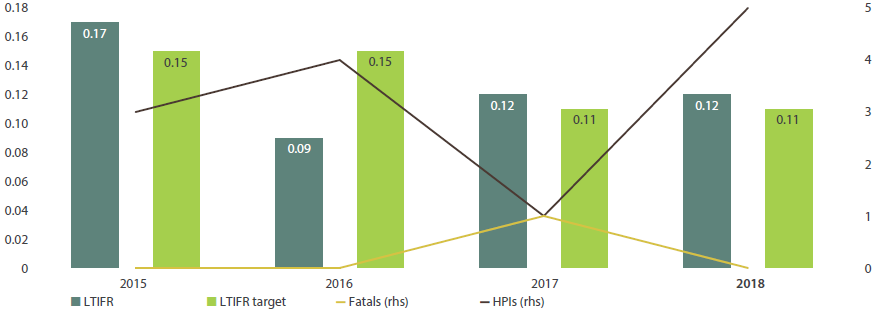Exxaro Resource limited Report Selector 2018



Currently viewing Supplementary Report 2018




Currently viewing Supplementary Report 2018


Highlights |
|
Fatality-free year |
Lowlights |
|
Missing the 0.11 LTIFR target |
| Five high-potential incidents reported |
Our business depends on the safety of our people, and we will not rest until we consistently achieve our vision of zero harm through collective responsibility, commitment and ongoing focus.
As part of this focus, all operational business units have international health and safety accreditation (OHSAS 18001).
Our target remains zero injuries and fatalities. To reach this goal, we review our LTIFR target annually based on prior performance, and apply stringent management protocols, programmes and systems. Every LTI is investigated by the business unit management team, while all fatalities and high-potential incidents are investigated by a skilled committee, headed by an independent chairperson. Findings are reported to the executive committee and sustainability, risk and compliance committee and escalated to the board. Each business unit tracks its adherence to standards and legislation through a safety improvement plan of self-assessments and corporate audits.
In risk-specific terms, the leading causes of injury remain fall-of-ground, lifting, materials handling and vehicle safety. While key risks differ by operation, our major challenges are vehicle incidents, energy and machinery isolation, as well as risk awareness and discipline at all levels. We concentrate on training on the job to ensure sufficient trained people are in the right positions in our work areas.
Operations falling under the Mine Health and Safety Act (1996) (MHSA) have elected representatives on safety and health committees from management and operator level. Health topics included in formal agreements with trade unions cover HIV/Aids, occupational TB, NIHL and dust.
Our vision for health and hygiene is to create a workplace with no adverse effects on our employees and surrounding communities. We understand the health risks posed by our industry, and the importance of programmes to reduce new cases of occupational diseases and ensure a healthy workforce:
Our target was zero fatalities and an LTIFR (lost-time injury-frequency rate per 200 000 hours worked) of 0.12 for 2018. Importantly, Exxaro had no fatalities in 2018 but the actual LTIFR of 0.11 is 8% above target.
The group safety strategy was revised, with several focus areas identified by leadership:
In 2018, the group was served with five section 54 notices, all amicably resolved with the authorities.
| Our safety performance over four years is trending in the right direction, but our aim remains zero harm |
 |
Reported occupational diseases
Reported cases are those newly diagnosed and submitted to the authorities to confirm whether they are work-related and eligible for compensation under related legislation.
In 2018, Exxaro reported 65 cases of occupational diseases (2017: 57): 42 occupational tuberculosis (TB), 11 NIHL, four chronic obstructive airways disease and eight pneumoconiosis. While the number of cases is higher, it reflects our focus on occupational risk exposure profiles to further reduce the incidence of occupational diseases.
Exxaro – reported occupational diseases (cumulative)
| 2018 | 2017 | 2016 | 2015 | 2014 | 2013 | |||
| NIHL | 11 | 12 | 17 | 15 | 16 | 8 | ||
| Pneumoconiosis | 8 | 18 | 5 | 15 | 12 | 37 | ||
| Silicosis | 0 | – | – | – | – | |||
| Chronic obstructive airways disease | 4 | 1 | 4 | 1 | 4 | 2 | ||
| Occupational TB | 42 | 26 | 26 | 18 | 20 | 40 | ||
| Dermatitis | 0 | – | – | – | – | |||
| Asbestosis | 0 | – | 1 | – | – | |||
| Work-related upper limb disorders | 0 | – | – | – | – | |||
| Total | 65 | 57 | 52 | 60 | 52 | 87 |
Historically, health management has been curative in nature where we treat people who have become ill.
Our current approach is increasingly proactive to ensure our employees are fit for work through specific interventions including:
Our goal is to ensure that our employees are not merely fit for work, but fit for life by creating a culture where they take responsibility for their own health and feel empowered to initiate medical assessments, health education and testing.
Accepted occupational diseases
These are cases where the condition is demonstrably work-related and accepted for compensation. In 2018, Exxaro had 12 occupational disease cases accepted for compensation: five for TB and seven for pneumoconiosis.
Mining sector targets on noise and silicosis
In 2003, the mining sector set targets to eliminate silicosis and NIHL.
| Noise | Silicosis | Current status | |||
|
|
|
|||
|
|
||||
We continue to implement hearing conservation and dust control programmes to reduce the number of new occupational diseases.
Occupational health programmes seek to prevent and mitigate related risks for permanent employees and contractors. These programmes facilitate the analysis, monitoring and management of exposure, and provide preventive measures for a range of occupational health risks. Exxaro focuses on effective employee communication on risk and prevention, and provides rehabilitation and return-to-work programmes.
We promote a healthy workforce through integrated health and wellness programmes. Wellness programmes, emphasising lifestyle diseases, aim to reduce health risks, provide access to healthcare, and educate, inform and empower employees to take responsibility for their own wellbeing. Focus is on reducing lifestyle diseases (such as hypertension, diabetes and cholesterol levels), managing the risks of human immunodeficiency virus (HIV) infection, and effectively managing mental health conditions.
Apart from HIV, chronic diseases are fast becoming the primary cause of death. In a survey covering the Exxaro group, the following conditions were identified:
Based on survey information, we integrated the prevention and control of chronic diseases into our workplace health programmes. This is supported by case management and monitoring the progress of individuals with chronic diseases. Awareness programmes on healthy living are ongoing.
As part of embedding the health operating model, we focused on our ability to address lifestyle health risks, particularly through our health centres. All operations in Mpumalanga and Limpopo have signed memorandums with provincial health departments to provide medication for these conditions on site.
For the review period, medical surveillance identified 100 new diabetes cases and 297 hypertensive employees and contractors.
HIV/Aids and TB
The prevalence of HIV/Aids across Exxaro is currently estimated at 9%, well below the industry and national average. With appropriate education, counselling and support, 90% of our workforce (excluding contractors) voluntarily tested between 2014 and 2017, and more are seeking treatment.
We recorded a drop in the number of employees and contractors enrolled on the HIV/Aids programme to 4 475 in 2018 (2017: 5 553), with 3 167 employees and contractors on antiretroviral treatment (ART).
Between January 2013 and December 2018, we have made headway in slowing the spread of HIV/Aids (detailed below):
HIV/Aids awareness
| Attended information session |
Tested | % tested | Employees testing positive |
Enrolled at December (cumulative) |
On ARVs | |
| 2013 | 5 853 | 3 756 | 64 | 314 | 545 | 521 |
| 2014 | 5 732 | 2 804 | 49 | 261 | 675 | 481 |
| 2015* | 11 759 | 4 158 | 35 | 252 | 453 | 452 |
| 2016* | 18 845 | 6 497 | 34 | 80 | 221 | 1 675 |
| 2017* | 16 788 | 3 513 | 188 | 350 | 4 547 | |
| 2018* | 18 657 | 9 492 | 77 | 356 | 4 475 | 3 167 |
| *Includes contractors. |
Tuberculosis and non-communicable diseases
In 2018, Exxaro reported an increase in TB cases. This is attributable to our health centres intensifying their testing regimes, resulting in earlier detection and treatment.
We are partnering with the Department of Health in managing TB, HIV/Aids and non-communicable diseases, including hypertension and diabetes.
In collaboration with the department, our health centres will act as facilities to monitor employees and contractors who have been diagnosed as well as collection points for medication distributed by the department's centralised chronic medicines dispensing and distribution (CCMDD) programme. This approach will reduce the burden on clinic staff in terms of daily consultation numbers and benefit our employees and contractors by reducing the need to travel to off-site clinics.
Exxaro has successfully implemented this partnership in Lephalale, identified as an area with a high TB prevalence.
Exxaro's employee assistance programme ensures that any of our people facing difficulties have access to an external counselling service. This is a preventive measure that helps employees manage personal concerns, and assists management in minimising productivity issues. Employees use the programme for a variety of personal and professional reasons, including: